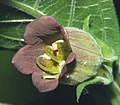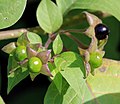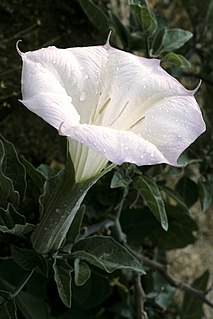
Datura is a genus of nine species of poisonous, vespertine-flowering plants belonging to the nightshade family Solanaceae. They are commonly known as thornapples or jimsonweeds, but are also known as devil's trumpets. Other English common names include moonflower, devil's weed, and hell's bells. All species of Datura are poisonous and potentially psychoactive, especially their seeds and flowers, which can cause respiratory depression, arrhythmias, fever, delirium, hallucinations, anticholinergic syndrome, psychosis, and even death if taken internally. Due to their effects and symptoms, they have occasionally been used not only as poisons, but also as hallucinogens by various groups throughout history. Traditionally, psychoactive administration of Datura species has often been associated with witchcraft and sorcery or similar practices in many cultures, including the Western world. Certain common Datura species have also been used ritualistically as entheogens by some Native American groups. Nonpsychoactive use of the plant is usually done for medicinal purposes, and the alkaloids present in plants of the Datura genus have long been considered traditional medicines in both the New and Old Worlds due to the presence of the alkaloids scopolamine and atropine, which are also produced by Old World plants such as Hyoscyamus niger, Atropa belladonna, and Mandragora officinarum.

Atropa is a genus of flowering plants in the nightshade family, Solanaceae: tall, calcicole, herbaceous perennials, bearing large leaves and glossy berries particularly dangerous to children, due to their combination of an attractive, cherry-like appearance with a high toxicity. Atropa species favour temperate climates and alkaline soils, often growing in light shade in woodland environments associated with limestone hills and mountains. Their seeds can remain viable in the soil for long periods, germinating when the soil of sites in which plants once grew is disturbed by human activity or by natural causes, e.g. the windthrow of trees. The best-known member of the genus Atropa is deadly nightshade - the poisonous plant par excellence in the minds of many. The pharmacologically active ingredients of Atropa species include atropine, scopolamine, and hyoscyamine, all tropane alkaloids having anticholinergic, deliriant, antispasmodic and mydriatic properties. The genus is named for Άτροπος (Atropos) - lit. 'she who may not be turned (aside)' - one of the Three Fates and cutter of the thread of life / bringer of death - in reference to the extreme toxicity of A.belladonna and its fellow species - of which three others are currently accepted.

Atropa belladonna, commonly known as belladonna or deadly nightshade, is a toxic perennial herbaceous plant in the nightshade family Solanaceae, which also includes tomatoes, potatoes, and eggplant (aubergine). It is native to Europe, North Africa, and Western Asia. Its distribution extends from Great Britain in the west to western Ukraine and the Iranian province of Gilan in the east. It is also naturalised or introduced in some parts of Canada and the United States.

Hyoscyamine is a naturally occurring tropane alkaloid and plant toxin. It is a secondary metabolite found in certain plants of the family Solanaceae, including henbane, mandrake, angel's trumpets, jimsonweed, tomato, the sorcerers' tree, and deadly nightshade. It is the levorotary isomer of atropine and thus sometimes known as levo-atropine.

A besom is a broom, a household implement used for sweeping. The term is now mostly reserved for a traditional broom constructed from a bundle of twigs tied to a stout pole. The twigs used could be broom, heather or similar. The song "Buy Broom Buzzems" from Northern England refers to both types of twig. From the phrase broom besom the more common broom comes. In Scotland, besoms are still occasionally to be found at the edge of forests where they are stacked for use in early response to an outbreak of fire.

Flying ointment is a hallucinogenic ointment said to have been used by witches in the practice of European witchcraft from at least as far back as the Early Modern period, when detailed recipes for such preparations were first recorded.

Deliriants are a class of hallucinogen. The term was coined in the early 1980s to distinguish these drugs from psychedelics and dissociatives such as LSD and ketamine, due to their primary effect of causing delirium, as opposed to the more lucid and less disturbed states produced by other types of hallucinogens. The term generally refers to anticholinergic drugs, which are substances that inhibit the function of the neurotransmitter acetylcholine. Common examples of deliriants include plants of the genera Datura and Brugmansia as well as higher than recommended dosages of diphenhydramine (Benadryl). A number of plant deliriants such as that of the Solanaceae family, particularly in the Americas have been used by some indigenous cultures to reach delirious and altered states for traditions or rituals, such as rites of passage, divination or communicating with the ancestors. Despite their long history of use, deliriants are the least-studied class of hallucinogens in terms of their behavioral and neurological effects.

Nicandra physalodes is a species of flowering plant in subfamily Solanoideae of the nightshade family. It is known by the common names apple-of-Peru and shoo-fly plant. It is thought originally to have been native to western South America, including Peru, and is known elsewhere as an introduced and ruderal species – sometimes as a weed – in tropical, subtropical and, to a lesser extent, temperate areas all over the world. It has also long been cultivated as an ornamental plant for its attractive flowers and curious fruits and has been adopted into the traditional medicine of countries far-removed from its original home.

Scopolia is a genus of four species of flowering plants in the family Solanaceae, native to Europe and Asia. The genus is named after Giovanni Scopoli (1723–88), a Tyrolean naturalist. The genus has a disjunct distribution, with two recognised species in Central to Eastern Europe,, and two species in East Asia. The two European species are:

Anisodus tanguticus is a species of flowering plant in the family Solanaceae which includes many important agricultural plants. It is mostly found growing in the Qinghai-Tibetan Plateau. A. tanguticus is collected and used mostly for its medicinal effects thought to be derived from the plant's biologically active nicotine and tropane alkaloids. It has a significant impact in China as one of the 50 fundamental herbs used in traditional Chinese medicine.

Iochroma arborescens is a species of flowering plant in the genus Iochroma, belonging to the nightshade family Solanaceae. Formerly it was considered the single species in the monotypic genus Acnistus. Common names include gallinero, mata-gallina, fruta-de-sabiá, hollowheart, wild tobacco, siyou, bastard sirio, galán arbóreo, tabaco de monte, nigüito, marieneira, güitite, and tabak djab.
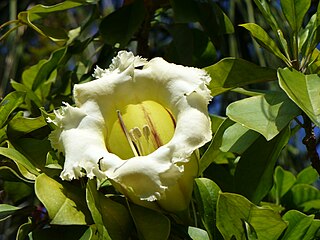
Solandra grandiflora, the showy chalicevine, or papaturra is a member of the nightshade genus Solandra and, like the other members of the genus, is a climbing plant with large, attractive, trumpet-shaped flowers. It is native to Central America and northern South America and is widely grown in the tropics as an ornamental. The green parts of the plant are highly toxic, due to tropane alkaloid content, and have caused deaths from anticholinergic poisoning, but the flesh of the ripe fruit is said to be edible. The fruits, which are globular and largely enclosed by the accrescent calyces, can reach a kilogram in weight and have a taste described as apple-like or melon-like.

Scopolia japonica, also Japanese belladonna or Korean scopolia, is a flowering plant species in the genus Scopolia - one of the eight genera in tribe Hyoscyameae of the nightshade family Solanaceae.

Scopolia carniolica, the European scopolia or henbane bell, is a poisonous plant belonging to the family Solanaceae, It has dark violet flowers on long hanging stems. It grows to 60 centimetres (24 in) in height. Its toxicity derives from its high levels of tropane alkaloids, particularly atropine. The concentration of atropine is highest in the roots.

Mandragora is a plant genus belonging to the nightshade family (Solanaceae). Members of the genus are known as mandrakes. There are between three and five species in the genus. The one or two species found around the Mediterranean constitute the mandrake of ancient writers such as Dioscorides. Two or three further species are found eastwards into China. All are perennial herbaceous plants, with large tap-roots and leaves in the form of a rosette. Individual flowers are bell-shaped, whitish through to violet, and are followed by yellow or orange berries.

The Solanaceae, or nightshades, are a family of flowering plants that ranges from annual and perennial herbs to vines, lianas, epiphytes, shrubs, and trees, and includes a number of agricultural crops, medicinal plants, spices, weeds, and ornamentals. Many members of the family contain potent alkaloids, and some are highly toxic, but many—including tomatoes, potatoes, eggplant, bell and chili peppers—are used as food. The family belongs to the order Solanales, in the asterid group and class Magnoliopsida (dicotyledons). The Solanaceae consists of about 98 genera and some 2,700 species, with a great diversity of habitats, morphology and ecology.
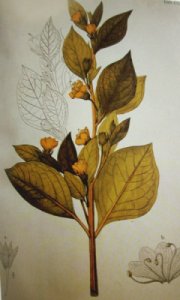
Atropa baetica is one of Europe's rarest wildflowers. A close relative of the infamous deadly nightshade its specific name derives from that of the Roman province of Hispania Baetica, while its common name refers to the Spanish region of Andalucía – both designating the area in the south of Spain where it is most frequently encountered. It is an attractive, perennial herbaceous plant bearing infundibuliform, yellow or greenish flowers and shiny, black berries. Like the other three species of Atropa, it is an extremely poisonous plant, containing a variety of tropane alkaloids with anticholinergic, deliriant, antispasmodic and mydriatic properties. Although most populations of the plant are to be found in Spain, it is not wholly confined to the Iberian Peninsula of Europe, occurring also in certain localities in Morocco and Algeria in the Atlas Mountains of North Africa. The Rif and the Baetic System, which face each other across the Alboran Sea, together constitute one of the finest of the Mediterranean biodiversity hotspots – rich in endemic species, of which Atropa baetica is a notable example..

Physochlaina is a small genus of herbaceous perennial flowering plants belonging to the nightshade family, Solanaceae, found principally in the north-western provinces of China although one species occurs in Western Asia, while another is found as far east as those regions of Siberia abutting the eastern borders of Mongolia and, furthermore, not only in Mongolia itself, but also in the Chinese autonomous region of Inner Mongolia. Some sources maintain that the widespread species P. physaloides is found also in Japan, but the species is not recorded as being native in one of the few English-language floras of the country. The genus is a valuable one, since its species are not only of considerable medicinal value, being rich in tropane alkaloids, but also of ornamental value, three species having been grown for the purpose, although hitherto infrequently outside botanical gardens. Furthermore, the genus contains a species formerly used as an entheogen in Siberia.
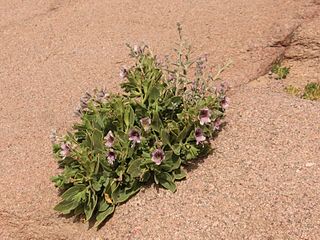
Hyoscyamus muticus, the Egyptian henbane, is a shrub in the family of Solanaceae that is native to desert areas of North Africa. It contains alkaloids that are useful in pharmaceuticals. It is used locally as a painkiller and a recreational drug. In high dosages it can be fatal.







